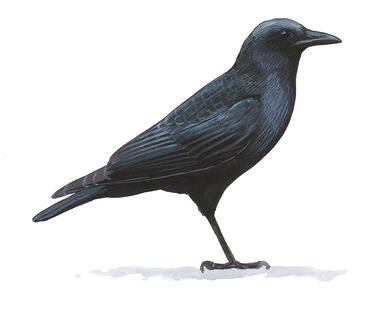 Audubon field guide to North American birds,"Some of our favorite birds." Visual, written, and voice recognition descriptions of 32 birds, many of whom we see in our city and in our yards.
Audubon field guide to North American birds,"Some of our favorite birds." Visual, written, and voice recognition descriptions of 32 birds, many of whom we see in our city and in our yards. 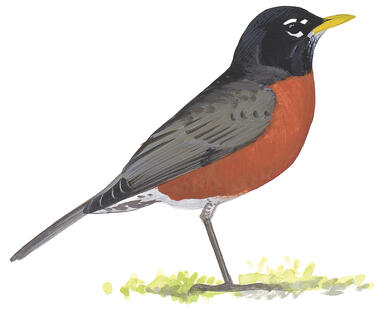 For more information on the following birds and more, in the Audubon field guide above, click on the sound and the bird, and the bird itself.
For more information on the following birds and more, in the Audubon field guide above, click on the sound and the bird, and the bird itself.
"American Crow (family Crows, Magpies, Jays). Habitat: Woodlands, farms, fields, river groves, shores, towns. Lives in a wide
variety of semi-open habitats, from farming country and open fields to
clearings in the woods. Often found on shores, especially where Fish
Crow and Northwestern Crow do not occur. Avoids hot desert zones. Is
adapting to towns and even cities, now often
nesting in city parks.
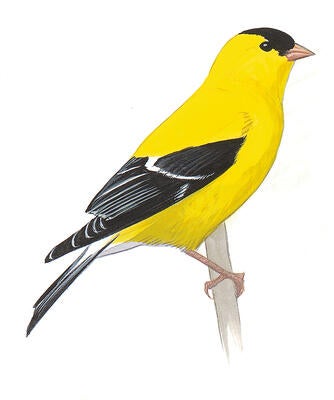
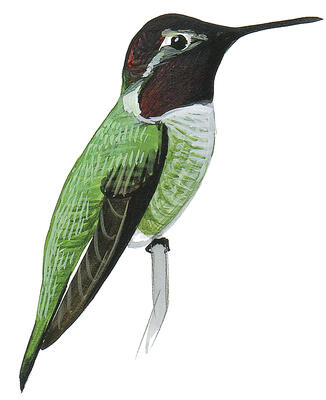 American Goldfinch (family Finches). Habitat: Patches of thistles and weeds, roadsides, open woods, edges. Found at
all seasons in semi-open areas having open weedy ground and some trees
and bushes for shelter, especially areas of second growth, streamsides,
roadsides, woodland edges, orchards, suburban areas. In winter also in
some very open fields farther from trees.
American Goldfinch (family Finches). Habitat: Patches of thistles and weeds, roadsides, open woods, edges. Found at
all seasons in semi-open areas having open weedy ground and some trees
and bushes for shelter, especially areas of second growth, streamsides,
roadsides, woodland edges, orchards, suburban areas. In winter also in
some very open fields farther from trees.
American Robin (family Thrushes). Habitat: Cities, towns, lawns, farmland, forests; in winter, berry-bearing trees.
Over most of continent, summers wherever there are trees for nest sites
and mud for nest
material. In arid southwest, summers mainly in
coniferous forest in mountains, rarely in well-watered lowland suburbs.
In winter, flocks gather in wooded areas where trees or shrubs have good
crops of berries.
American Tree Sparrow (family New World Sparrows). Habitat: Arctic scrub, willow thickets; in winter, brushy roadsides, weedy edges,
marshes. In summer most common near treeline, where northern forest
gives way to tundra. May be in openings in stunted spruce forest, or on
open tundra if a few taller shrubs are present. In winter in open
fields, woodland edges, marshes, suburban areas.
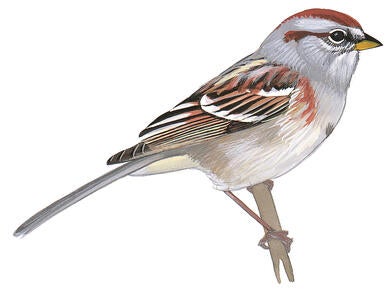 Anna's Hummingbird (family Hummingbirds). Habitat: Gardens, chaparral, open woods. Found in a wide variety of habitats
within its range, including stream side groves, chaparral, open oak
woodland, coastal sage scrub, gardens, city parks. Most common in
lowlands and lower mountain slopes, but may wander to high mountain
meadows in late summer."
Anna's Hummingbird (family Hummingbirds). Habitat: Gardens, chaparral, open woods. Found in a wide variety of habitats
within its range, including stream side groves, chaparral, open oak
woodland, coastal sage scrub, gardens, city parks. Most common in
lowlands and lower mountain slopes, but may wander to high mountain
meadows in late summer."
----------
Related - Pacifica, Williams, OR: Parallel universe, some hippies may think they're living in Pacifica nature center, OR. - Garden Organization, Williams, Oregon, (founded 1998). Pacifica is located in the beautiful and amazingly bio-diverse
Klamath-Siskiyou Region of Southwestern Oregon. Sited in the
Applegate/Williams Valley, Pacifica’s total of 540 historic acres are
dedicated to providing education about our natural environment while
enhancing the learner’s understanding and appreciation of the natural
world and how it relates to daily life." "Birds of Pacifica," Pacifica nature center, Williams, OR. Again, not this City of Pacifica, but many of the same birds also visit Pacifica, CA. "The Nature Center is an ideal place for birding! The Audubon Club has
identified over 100 species here." History: you tube, 2:39 minutes, continues 9:02 minutes. Miscellaneous: Pacifica , Williams, OR not only has a Garden Club, but they also have an Arts Guild. An area fire, 500+ acres, William, Oregon, 7/22/13, you tube, 7:27 minutes.
Related Pacifica, CA - Pacifica Shorebird Alliance. "The
group of birds known as shorebirds is comprised of the sandpipers,
plovers and related birds that forage along our beaches, mudflats and
rocky shores. Some species, like Snowy Plovers, Black Oystercatchers,
and Spotted Sandpipers, nest in our area, but most shorebirds are only
winter visitors to the California coast, nesting elsewhere to the east
and north. Many species of shorebirds travel north all the way to the
tundra to lay their eggs and raise their young. "
Posted by Kathy Meeh


14 comments:
You are not seeing Tree Sparrows in local Pacifica yards. Please don't post nonsense on your blog to give the impression you too are an environmental advocate.
Are Crows and Ravens the same bird?
No.
Sourpuss Anonymous 1134, birds fly though our yards. Some (such as hummingbirds) hang around. Sparrows exist in varieties (similar to plovers). I have seen one variety of sparrow which looks exactly like this American Tree Sparrow-- so, best I can identify, that's him. There are many other birds and their varieties that fly through during the year.
This is daily observation of what exists in our environment with people and "our economy" as well. Daily interaction with, respect and observation of our environment is quite different from extreme environmentalism, which tends to hold an attitude of rejecting balance.
@11:34 I see tree sparrows. I also see unicorns and a 6 foot rabbit named Harvey. What's it to you? Pretty arrogant of you to make yourself the decider as to who is an environmentalist and who is not. Pretty damn arrogant.
913, I do not see unicorns or Harvey. I do observe that those who claim to be environmentalist in this city work against the structural economic balance of this city. But that observation is kind of like identifying an ordinary sparrow, nothing special.
9:13 My arrogance knows no bounds. Of course you see unicorns that's obvious, but it would be arrogant to say call you a unicorn advocate,my hypocrisy only goes so far.
It's puff puff pass you stoners!
Kathy you don't see tree sparrows and birds don't come in "varieties". They have a name for being wrong to "achieve balance", it's called being wrong. Near enough in science doesn't cut it, ask your doctor if you are unsure of he concept.
9:37, your comment doesn't cut-it. And if you want to be picky use "species", rather nothing. Imagine, you actually drifted your comment to nowhere.
The word I intended is varieties. And the topic is casual, observed transient bird activity in one's back yard. The topic is not advanced Ornithology, nor is it the study or inquiry of medicine.
WOW! 9:37 really schooling us on environmental science and vernacular. How lucky we are to have a credentialed scientist on board. Who wooda thunk? If this were Riptide, we would be building an alter to honor them.
Makes me want to put on the ol' Birkenstocks and march out to Linda Mar Beach and rip out even more of that ugly iceplant (you know, that horrible stuff that the Army Corps of Engineers planted to control erosion) and replace it with little flags to commemorate the dead weeds that took its place. And while I'm there, maybe I can saunter over and look through the fence at the Western Snowy Plover protected habitat. Oh wait, the plover doesn't nest at LMB and USFWS has never declared it to be protected habitat. Oh well... Guess the scientists like 9:37 know better.
As real estate prices keep going up more and more "thinkers" will be moving in... and the "thunkers" will have to make due elsewhere. Thinkers will demand clean beaches, open space, and better quality services and retail. It's the new Pacifica, get used to it.
325 It's bullshit and you're neck deep in it.
We live in Pacifica and saw four tree swallows in our yard today! I found this blog by googling what they looked like. Confirmed it was tree swallows by cross-referencing the chirps they made on youtube. Thanks for this post!
Post a Comment